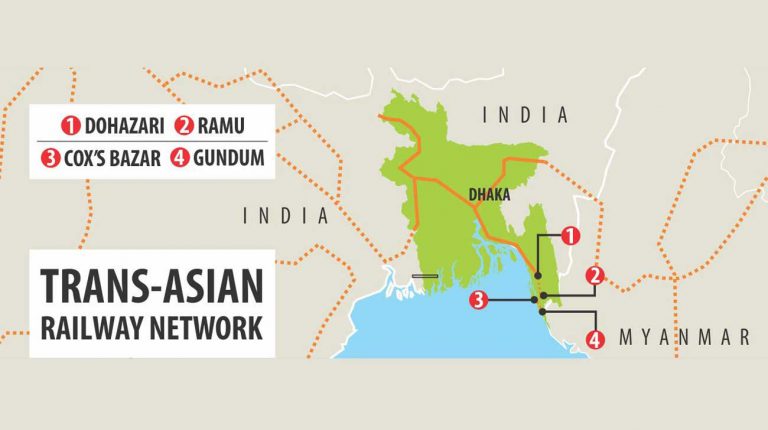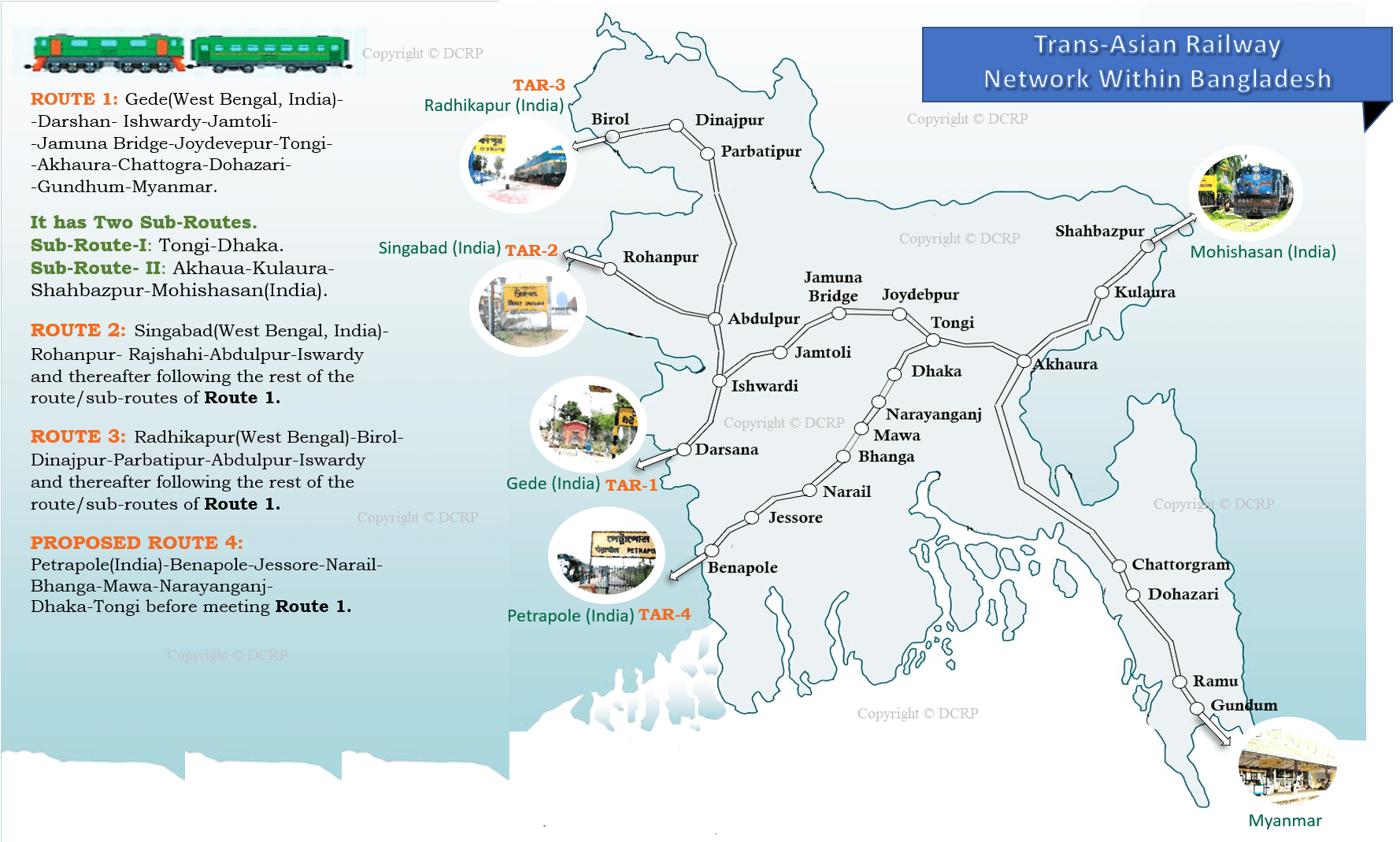Trans-Asian Railway Network
The Trans Asian Railway Network is a regional transport cooperation platform aimed at enhancing the efficiency and development of the railway infrastructure in Asia. It a part of ESCAP’s overall goal to see the development of an international, integrated, intermodal transport and logistics system for the region, with the Asian Highway and Trans-Asian Railway networks and dry ports of international significance as major components. The Trans-Asian Railway Network now comprises approximately 125,500 km of railway lines serving 28 member countries.
Agreement :
The Trans Asian Railway Network Agreement is an agreement signed on 10 November 2006, by seventeen Asian nations as part of a United Nations Economic and Social Commission for Asia and the Pacific (UNESCAP) effort to build a transcontinental railway network between Europe and Pacific ports in China. The plan has sometimes been called the “Iron Silk Road” in reference to the historical Silk Road trade routes. UNESCAP’s Transport & Tourism Division began work on the initiative in 1992 when it launched the Asian Land Transport Infrastructure Development project. On June 11, 2009, the agreement was formally put into effect.
Railway Routes :
At the beginning, three routes of TAR had passed through Bangladesh.
Route 1 – Gede (West Bengal, India) Darshana ( Chuadanga, Bangladesh) – Ishwardy – Jamtoli – Jamuna Bridge – Joydevepur – Tongi – Akhaura – Chattogram – Dohazari – Gundhum – Myanmar.
It has Two Sub-Routes.
Sub-Route – I : Tongi – Dhaka
Sub-Route – II : Akhaura – Kulaura –
-Shahbazpur – Mohisasan(India)
Route 2 – Singabad ( West Bengal) – Rohanpur – Rajshahi ( Bangladesh) – Abdulpur – Iswardy and thereafter following the rest of the route/sub-routes of Route 1.
Route 3 – Radikkapur (West Bengal) – Birol – Dinajpur- Parbatipur – Iswardy and thereafter following the rest of the route/sub-routes of Route 1.
With the building of a double-decker bridge(roadway on the top and railway on the bottom) over the Padma River, the country enters a new era of railway connectivity. Bangladesh Railway has already undertaken a project titled “Padma Bridge Rail Link Project(PBRLP)” to connect the capital and Jessore with a 169km rail line via the Padma Bridge at the cost of 39,246 crore.
Route 4 – The route would run through:
Petrapole(India) – Benapole – Jessore – Narail – Bhanga – Mawa – Narayanganj – Dhaka – Tongi before meeting Route 1.
International Connectivity (Railway Routes) :
“The TAR was seen as a way to accommodate the huge increases in international trade between Eurasian nations and facilitate the increased movements of goods between countries. It was also seen as a way to improve the economies and accessibility of landlocked countries like Laos, Afghanistan, Mongolia, and the Central Asian republics. Much of the railway network already exists as part of the Eurasian Land Bridge, although some significant gaps remain. For the most part the TAR would not change national gauges; mechanized facilities would be built to move shipping containers from train to train at the breaks of gauge.
The network was initially divided into four major components. They are:
(i) A northern corridor connecting the rail networks of China, Kazakhstan, Mongolia, the Russian Federation and the Korean Peninsula.
(ii) A southern corridor connecting Thailand and the southern Chinese province of Yunnan with Turkey through Myanmar, Bangladesh, India, Pakistan, the Islamic Republic of Iran and Sri Lanka.
(iii) A sub regional network covering the ASEAN and Indo-China sub regions, and
(iv) A north-south corridor linking Northern Europe to the Persian Gulf through the Russian Federation, Central Asia and the Caucasus region.”
Participating Nations :
Transportation and railway ministers from forty one nations participated in the week-long conference[10] held in Busan, South Korea, where the agreement was formulated. The proposed 80,900-km railway network will originate from the Pacific seaboard of Asia and end on the doorsteps of Europe. The agreement’s cosigners included the following participating countries:
Afghanistan | Armenia | Azerbaijan | Bangladesh | Belarus | Bhutan | Brunei | Cambodia | China | India | Indonesia | Iran | Kazakhstan | Laos |
Mongolia | Nepal | Pakistan | South Korea | Russia | Sri Lanka | Tajikistan | Thailand | Turkey | Turkmenistan | Uzbekistan
The 28 countries that did not sign the agreement at the conference had until 31 December 2007, to join and ratify the agreement.
On 5 May 2007, officials in Bangladesh announced that the nation will sign on to the agreement at an upcoming meeting in New York City. The plan for the network includes three lines between India and Myanmar that traverse Bangladesh. India made a similar announcement on 17 May 2007. As part of the agreement, India will build and rehabilitate rail links with neighboring Myanmar in projects that are estimated to cost more than US$730 million. Bangladesh finally signed the agreement on 10 November 2007.
India’s Look-East connectivity policy has resulted in the launch of several connectivity projects with China and ASEAN nations.
Trans Asian Railway Network Benefits :
The Trans Asian Railway Network has the potential to offer a range of benefits to the countries and regions connected by it, including:
1. Improved connectivity: The TAR network would enhance connectivity between Asia and Europe, as well as among the countries and regions within Asia. This improved connectivity would facilitate the movement of people, goods, and services, promoting regional integration and development.
2. Trade facilitation: The TAR network would provide a more efficient and cost-effective way of transporting goods across the region, reducing shipping times and costs. This would help to boost trade among the countries and regions connected by the network.
3. Economic development: The TAR network would help to stimulate economic growth and development, particularly in the less developed regions of Asia. By providing better connectivity and access to markets, the network would help to attract investment, create jobs, and boost incomes.
4. Social development: The TAR network would also have social benefits, such as improving access to education, healthcare, and other essential services. It could also help to promote cultural exchange and mutual understanding among the countries and regions connected by the network.
Overall, the TAR network has the potential to be a transformative infrastructure project that could contribute to the development and integration of Asia and beyond.









